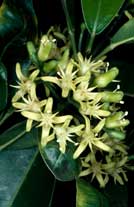In Flower This Week
A news sheet prepared by a Gardens' volunteer.
Numbers before each plant refer to temporary IFTW labels in the gardens.
Numbers in square brackets [ ] refer to garden bed Sections. Plants in flower are in bold type.
View past issues of 'In Flower This Week'.
15 April 2015
Acronychia littoralis click for larger image |
Today we will walk from the Visitor Information Centre (VIC) to the Rock Garden.
- Platytheca galioides [Section 221] is on the left-hand side in a pot as you leave the VIC. This plant, native to south-western Western Australia, has fine foliage and deep purple bell flowers with dark red centres.
- Further along in a pot on the right is Banksia prionotes [Section 174], commonly known as Acorn Banksia or Orange Banksia, which has toothed linear foliage and orange cones with a felty texture. This plant is native to sout-hwestern Western Australia.
- On your left is Prostanthera phylicifolia [Section 210], or Spiked Mint-bush, which has masses of small mauve flowers on a lax bush which scrambles down a bank. It grows naturally in eastern mainland Australia.
- Bear left up the hill behind the café to see on your left Acronychia littoralis [Section 114]. This small tree is endangered in the wild and has shiny leaves and strongly-scented greenish-cream flowers. The Scented Acronychia or Beach Acronychia grows naturally in north-eastern coastal New South Wales and a few areas in adjacent Queensland.
- Turn right towards the Rock Garden on the Main Path. On your left is Banksia aemula [Section 15c], or Wallum Banksia, a small gnarled tree with knobby bark and large squat green cones. This plant can be found in coastal heath on sandy soils from Bundaberg in Queensland to Sydney in New South Wales.
- Just before you reach the entrance to the Rock Garden, on your left is Hibbertia scandens [Section 15c], or Snake Vine. This popular and vigorous climber with large yellow flowers is found along the coast of New South Wales and Queensland.
- Just after you enter the Rock Garden and go up the steps, on your right is Lomatia tinctoria [Section 15d] with sprays of scented white curled flowers on upright divided foliage. Commonly known as Guitar Plant, this is one of three species of Lomatia endemic to Tasmania.
- Further on your left is Banksia integrifolia subsp. integrifolia [Section 15c], or Coast Banksia, a vigorous mound of foliage and flowers. The leaves are dark green with silver backs and there are plenty of short greenish-yellow cones.
- On your right is Correa ‘Ivory Bells’[Section 15d], with creamy bell flowers on darker green silver-backed foliage. This very floriferous cultivar originated in San Francisco, USA and is said to have C. alba and C. backhouseana as its parents.
- Also on your right is Banksia spinulosa ‘Honeypots’ [Section 15d], a medium-sized bush with fine, upright toothed foliage and many golden cones.
- Chrysocephalum apiculatum [Section 15d], low down on your right, has bright golden-orange button flowers on grey-green foliage. This plant is found in all states and territories in Australia in a wide range of environments.
- On your left in a pot is Acacia pterocaulon [Section 15e], with large gold balls of flowers on long flattened stems. This wattle is a Western Australian species.
- Grevillea manglesii [Section 15d], or Birdsfoot Grevillea, on your right, is a large bush with frothy white terminal clusters of flowers and tripartite ‘birdsfoot’ foliage. It is native to Western Australia.
- Cross the plank bridge to see high on your left Acacia aneura var. aneura [Section 15l], or Mulga, with fine grey-green needle foliage and short rods of yellow flowers. Mulga, which is widespread in inland Australia, is believed to live as long as 400 years.
- Also on your left is an attractive clump of Banksia spinulosa ‘Birthday Candles’[Section 15l], forming a mound of green linear foliage with masses of golden cones with rusty red styles.
Rosalind Walcott
![Director of National Parks [logo]](../../../../images/dnp_90px.gif)







